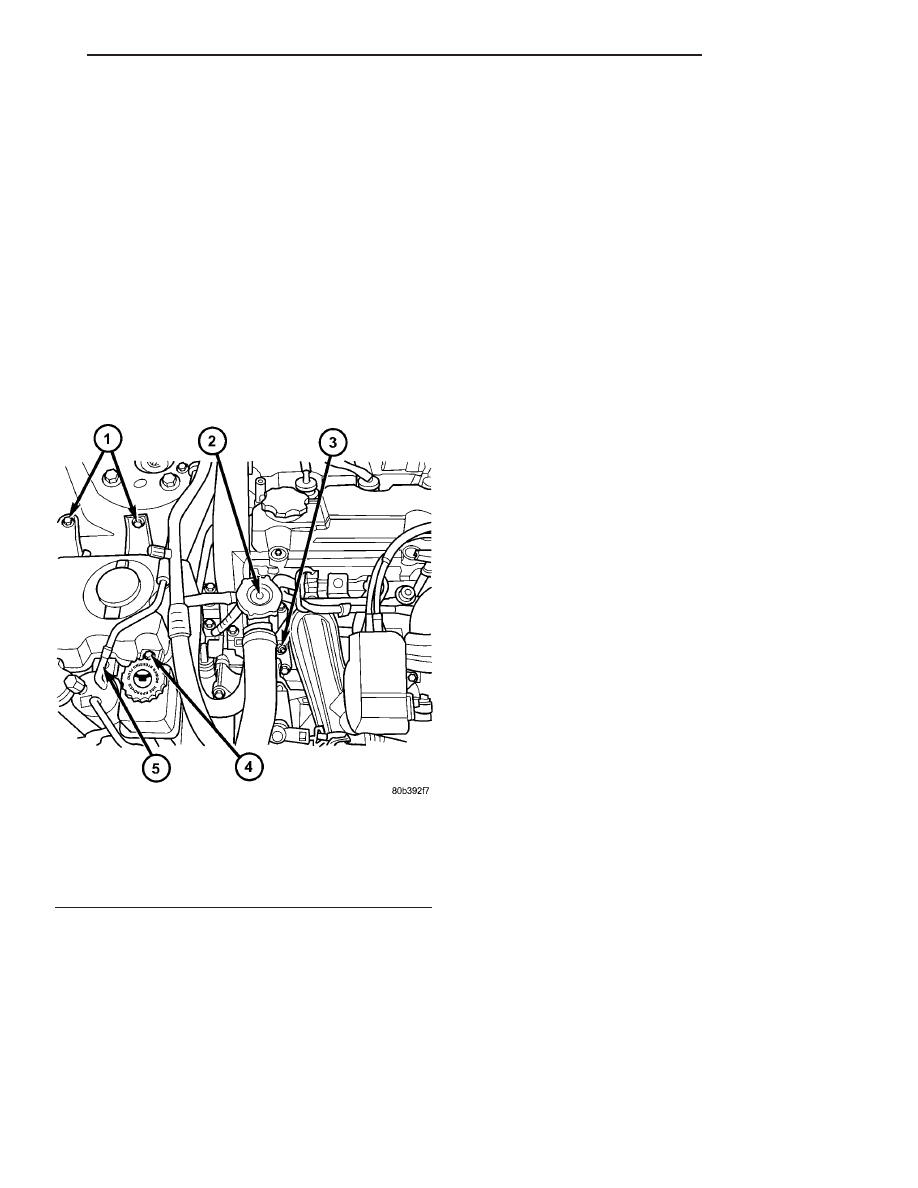Chrysler Sebring, Stratus sedan, Sebring Convertible. Manual - part 308

(4) Remove cooling system pressure cap and fill
cooling system with recommended coolant.
(5) Slowly continue filling until a steady stream of
coolant flows from attached hose on bleed valve.
(6) Close bleed valve and remove hose.
(7) Fill coolant to the top of pressure cap neck.
(8) Install cooling system pressure cap.
(9) Fill coolant recovery container to the MAX
mark.
(10) Start engine and allow to run until thermo-
stat opens and radiator fans cycle.
NOTE: It may be necessary to add additional cool-
ant to the coolant recovery container after three or
four warm-up/cool down cycles to maintain coolant
level between the MIN and MAX marks; as addi-
tional trapped air is removed from the system.
FILLING - 2.7L
(1) Close radiator draincock by turning clockwise.
NOTE: IT IS IMPERATIVE THAT THE COOLING SYS-
TEM AIR BLEED VALVE BE OPENED BEFORE ANY
COOLANT IS ADDED TO THE COOLING SYSTEM.
FAILURE TO OPEN THE BLEED VALVE FIRST WILL
RESULT IN AN INCOMPLETE FILL OF THE SYSTEM.
(2) Open cooling system bleed valve (Fig. 9).
(3) Attach a 6.35 mm (0.250 in.) inside diameter
clear hose that is 120.0 cm (48 in.) long to the bleed
valve. Route the hose away from accessory drive
belts and radiator fan. Position the other end of hose
into a collecting container. The hose will prevent cool-
ant from contacting accessory drive belts and other
components.
(4) Remove cooling system pressure cap. Attach
Special Tool 8195, Filling Aid Funnel to coolant pres-
sure container filler neck.
(5) Use the supplied clip to pinch overflow hose
that connects between the two chambers of the pres-
sure container (Fig. 9).
(6) Pour coolant into the larger section of Filling
Aid Funnel (the smaller section of funnel is to allow
air to escape).
(7) Slowly continue filling until a steady stream of
coolant flows from attached hose on bleed valve.
(8) Close bleed valve and continue filling system to
top of Filling Aid Funnel.
(9) Remove clip from overflow hose.
(10) Allow coolant in Filling Aid Funnel to drain
into overflow chamber of pressure container.
(11) Remove Special Tool 8195, Filling Aid Funnel
and install pressure cap on pressure container.
(12) Remove hose from bleed valve.
(13) Start engine and allow to run until thermo-
stat opens and radiator fans cycle.
NOTE:
The engine cooling system will push any remaining
air into the pressure container within about one half
hour of normal driving. As a result, a drop in cool-
ant level in the pressure container may occur.
If the engine cooling system overheats and pushes
coolant into the overflow chamber of the pressure
container, this coolant will be sucked back into the
cooling system ONLY IF THE PRESSURE CAP IS
LEFT ON THE PRESSURE CONTAINER. Removing
the pressure cap breaks the vacuum path between
the two chambers of the pressure container and the
coolant will not return to the cooling system.
(14) Shut off engine and allow it to cool down. This
permits coolant to be drawn into the pressure cham-
ber.
(15) With engine COLD, observe coolant level in
pressure chamber. Coolant level should be within
MIN and MAX marks. Adjust coolant level as neces-
sary.
CLEANING
Drain cooling system and refill with clean water.
Refer to drain and fill procedures in this section. Run
engine with radiator cap installed until upper radia-
tor hose is hot. Stop engine and drain water from
system. If water is dirty; fill, run, and drain system
Fig. 8 Cooling System Filling - 2.0L/2.4L
1 - COOLANT RECOVERY CONTAINER FASTENERS
2 - COOLANT PRESSURE CAP
3 - COOLING SYSTEM BLEED VALVE
4 - POWER STEERING RESERVIOR FASTENER
5 - RECEIVER/DRIER FASTENER
JR
ENGINE
7 - 25
ENGINE (Continued)